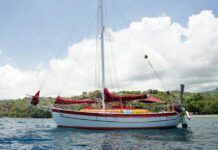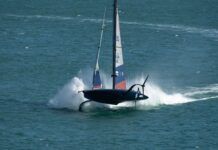The December 1996 issue contained a special section devoted to refrigeration. It dealt with icebox conversion kits (Adler-Barbour was best), thermoelectric coolers (Coleman was tops) and even discussed insulating blankets from Mainstay Designs (908/255-1995) and Standout Yacht Fittings (800/622-1877).

Given a page and a photo was the fairly expensive portable freezer called Norcold Tek II. Norcold is a large maker of small dual-voltage refrigerators. At the time, its portable freezer chest was unique—and expensive. We took a look at it in part because John Scofield, who purchased our 1967 Pearson Vanguard in 1989, installed a Tek II and reported favorably on its performance during his family’s cruise of the West Indies.
Norcold has more competitors now.
One of them is Innovative Marketing and Distributing Inc., the United States importer of freezer chests bearing the name “Engel.” The company president, Paul Kabalin, asked that Practical Sailor test two Engel models. One of them is a true freezer that will take the contents down around 0°F. The other is a cooler that drops the inside temperature to only a bit below 32°F.
In general, all of these portable freezers seem to us most worthwhile aboard a powerboat, which has ample power available.
Still, the ability to freeze food at home and transport it to any boat may be of value. However, their constant need for amps (because they do not hold their cold very long) makes them of marginal interest to a sailboat owner. That’s why no attempt was made to round up models from other competitors—like Cruisair, Explorer, Fridge-Mate and Minus-40. One can generally expect to use 2.5 to 3.5 amps continuous to keep the box cold; that’s 60 to 84 amp-hours per day. By comparison, an Adler-Barbour ColdMachine, which can cool the much larger ice box built into your boat, can be expected to consume about 60-65 amp-hours per day.
All of these devices contain miniature refrigeration machinery no different than is in home refrigerators. They have compressors that pressurize a gas as it passes through a condenser, losing heat as it liquefies. The liquid is circulated through a coil where it expands and draws heat from the air. The liquid-turned-gas then returns to the compressor. The first patent was in 1834.
The test of the Engel portables was set up to match the criteria used in 1996 to test the Norcold Tek II. The Norcold operates on 12VDC or 110VAC, with automatic switching. The Engels operate only with 12VDC and, according to the instructions, should not be hooked up to chargers or converters.
For the test, they were connected through a LCD digital auto-ranging multimeter to a fully charged 12V battery being constantly charged. The ambient and inside-the-chest temperatures were taken with accurate thermometers. As was done with the Norcold, the chest was opened very briefly at timed intervals to read the inside temperature.
No surprises were expected to emerge from the testing.
That’s because it was learned along the way that Norcold and Engel are made by the same Japanese company. The Engel name is used in Europe and, until this most recent importation into the United States, differs from the US Norcolds only in the power requirements. Europe uses 50 Hertz vs. 60 Hertz in the US. Paul Kabalin of Innovative Marketing said that the new Engel units incorporate “the latest technology,” especially noting their patented Swing Motor compressor and the ability to operate efficiently at up to 30° heel, whereas most similar units cannot tolerate angles more than about 5°.

This evaluation compares a Norcold freezer (tested three years ago), an Engel freezer and an Engel cooler. The 62-lb. Norcold has an inside volume of 1.46 cubic feet; the 25-lb. Engel freezer has .49 cubic feet inside. The Engel cooler’s interior is 1.0 cu. ft.; it weighs 22 lbs.
The Bottom Line
The Norcold freezer outperformed the Engel freezer by a slight margin. Using only slightly more power, the Norcold (with three times the interior volume) drove the temperature lower, kept it below freezing much longer and lost its cool at a much slower rate.
The Norcold has the additional advantage of being dual voltage; it runs on both 12VDC or 110VAC. The Engel freezer and the cooler, both 12V, require a transformer to operate on 110VAC.
The Engel freezer has a price advantage, but it’s smaller inside. The Norcold now sells for $820; the Engel for $550. And it weighs but a third of the hefty Norcold Tek II.
The Engel cooler (also $550) is not in the same league with the freezers. It won’t really freeze anything unless left inside for a long time. When the power is cut, it loses its cool in a comparative hurry. Because the Engel freezer has a cooler-freezer option selected with a simple switch, it is, for the same money, a much better buy than the Engel cooler.
However, if interior volume and good cold-holding ability on the level is what you seek, the Norcold is a better choice—at a price and substantially more weight. Our tests confirmed that the Engels continue to operate as before even when heeled to 30°, a significant consideration if you plan to use one of these units underway. (Innovative Marketing & Distribution, 22780 Marbella Circle, Boca Raton, FL 33433; 954/557-3775, www.i-m-d.com/engel/)






































